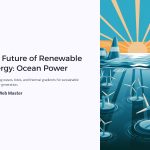 As the world shifts toward sustainable energy sources, ocean energy power plants are emerging as a promising solution. These facilities harness the immense power of waves, tides, and thermal gradients to generate electricity. With advancements in technology and increasing global energy demands, ocean energy could play a significant role in the future energy mix.
As the world shifts toward sustainable energy sources, ocean energy power plants are emerging as a promising solution. These facilities harness the immense power of waves, tides, and thermal gradients to generate electricity. With advancements in technology and increasing global energy demands, ocean energy could play a significant role in the future energy mix.

What Is an Ocean Energy Power Plant?
An ocean energy power plant is a facility that converts the energy from the sea into electricity. There are several types of ocean energy technologies, including tidal energy, wave energy, ocean thermal energy conversion (OTEC), and salinity gradient power. Each method has its own advantages and is suited to specific coastal and offshore conditions.
Tidal power plants, for example, use the gravitational pull of the moon and sun to generate energy. Wave energy systems, on the other hand, capture the kinetic energy of surface waves. Meanwhile, OTEC plants exploit temperature differences between warm surface water and cold deep water to produce power. These various approaches provide flexibility in how ocean energy can be harnessed globally.

How Do Ocean Energy Power Plants Work?
The operation of ocean energy power plants depends on the specific technology being used:
- Tidal Power Plants: These work similarly to hydroelectric dams, using turbines installed in tidal channels to capture the movement of water during high and low tides.
- Wave Energy Converters: Devices float on the ocean’s surface or are submerged, converting wave motion into mechanical energy and then into electricity.
- OTEC Systems: These use a heat exchanger to transfer energy from warm surface water to a working fluid, which evaporates and drives a turbine to generate electricity.
- Salinity Gradient Power: This method leverages the difference in salt concentration between seawater and freshwater to produce energy through osmosis.
Each of these technologies has its own efficiency levels and challenges, but continuous improvements are making them more viable for large-scale implementation.

Advantages of Ocean Energy Power Plants
Ocean energy power plants offer numerous benefits, making them an attractive renewable energy source:
- Sustainability: Unlike fossil fuels, ocean energy is renewable and virtually inexhaustible.
- Predictability: Unlike wind or solar power, tidal and wave energy are highly predictable, providing a stable power output.
- Minimal Land Use: Since these plants are built offshore or near coastlines, they do not occupy valuable land space.
- Low Environmental Impact: With proper planning, ocean energy facilities can operate with minimal disruption to marine ecosystems.
- High Energy Density: Compared to solar and wind, ocean energy has a higher power density, allowing for greater energy production in smaller areas.
These advantages make ocean energy a strong candidate for future renewable energy investments.

Challenges Facing Ocean Energy Development
Despite its potential, ocean energy power plants face several challenges:
- High Initial Costs: Constructing offshore facilities is expensive due to the need for durable materials and underwater infrastructure.
- Harsh Marine Environment: Saltwater corrosion, extreme weather conditions, and biofouling pose significant maintenance challenges.
- Limited Deployment Areas: The best sites for tidal and wave energy plants are geographically restricted to specific coastal regions.
- Technological Barriers: Many ocean energy technologies are still in the experimental phase and require further development before commercial viability.
Addressing these challenges will require continued research, investment, and government support.

Real-World Examples of Ocean Energy Power Plants
Several countries have already implemented ocean energy projects, demonstrating their feasibility:
- Sihwa Lake Tidal Power Station (South Korea): The world’s largest tidal power plant, producing 254 MW of electricity.
- La Rance Tidal Power Plant (France): A pioneering project that has been generating power since 1966.
- MeyGen (Scotland): One of the largest tidal stream energy projects in operation.
- Mutriku Wave Power Plant (Spain): A wave energy facility that supplies power to the grid.
These examples show that ocean energy can successfully contribute to national power grids.

The Future of Ocean Energy Power Plants
Looking ahead, ocean energy is poised for significant growth. Advances in materials, engineering, and grid integration will make these plants more efficient and cost-effective. Governments and private companies are investing in research to improve energy extraction and reduce costs.
With global efforts to reduce carbon emissions and reliance on fossil fuels, ocean energy power plants could become a cornerstone of the renewable energy landscape. As technology continues to evolve, ocean energy has the potential to supply a substantial portion of the world’s electricity needs.
*Capturing unauthorized images is prohibited*


